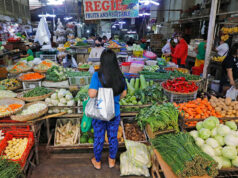Analysts divided on next rate move
By Melissa Luz T. Lopez
Senior Reporter
THE CENTRAL BANK could still raise interest rates on Thursday, according to half of analysts asked by BusinessWorld last week, although others expect monetary authorities to hold fire as policy tightening so far may have helped arrest inflation’s momentum but at the same time dampened economic growth.
The latest BusinessWorld poll among 11 economists resulted in a toss-up, with six betting that the Bangko Sentral ng Pilipinas (BSP) will keep rates steady and five others still seeing a good chance for a 25-basis-point (bp) hike.

The Monetary Board will hold its seventh rate-setting meeting on Thursday, which will follow a back-to-back 50bp increase in August and September. Benchmark rates are now at 4-5% as a result of a cumulative 150bp rate hike from the BSP since May. The key policy rate is now at 4.5%, the highest in nearly a decade.
“With food inflation easing, a general sentiment that price levels have peaked, and lower global fuel prices, I do not expect the BSP raising rates at its next policy meeting this month,” said Ruben Carlo O. Asuncion, chief economist at the Union Bank of the Philippines.
“This probable monetary policy stay is further bolstered by the ‘respectable’ Q3 GDP (gross domestic product) growth of 6.1%, with year-to-date print at a notable 6.3%.”
Inflation steadied at 6.7% in October, steady from September’s pace that was a nine-year high even as it capped a month-on-month rise seen since the start of the year. Food prices increased at a slower pace year-on-year that month, leading economic managers to say that state interventions to boost food supply have started to take effect. Month-on-month inflation eased to 0.3% from 0.9% in September.
Monetary Board Member Felipe M. Medalla had said that the central bank may consider pausing its tightening cycle amid signs that inflation momentum is abating.
On Tuesday, BSP Governor Nestor A. Espenilla, Jr. said October’s pace affirms the central bank’s view that price pressures are “finally moderating,” adding that this will be taken into account in deciding “if there’s still need for further policy rate adjustments.”
“The likelihood of a pause by the BSP has increased in light of the GDP data with the most glaring reason for the lower print pinned on slowing household final consumption,” Nicholas Antonio T. Mapa, senior economist at ING Bank NV Manila, said separately.
“Given that inflation peaked in September (6.70% versus 6.68% in October) and that inflation is seen to eventually move back within target by 2H 2019, the central bank can decide to… afford the economy some space to regain its breath and sustain above-6% growth into the medium term.”
Economic growth clocked in softer at 6.1% in the third quarter versus the upward-revised 6.2% climb in April-June as private consumption growth cooled to 5.2% year-on-year from 5.9% the previous quarter.
Third-quarter inflation pushed the nine-month growth pace to 6.3%, below the government’s tempered 6.5-6.9% growth target for 2018. GDP must now hit seven percent this quarter to hit 6.5% this year.
Other analysts, however, said a rate hike is still needed to anchor inflation expectations.
Michael L. Ricafort, economist at the Rizal Commercial Banking Corp., noted that the BSP may consider raising rates ahead of an expected 25bp hike by the United States Federal Reserve next month.
“I think BSP will raise policy rates by 25bp in next meeting in order to further cool inflationary expectations, after which we should see a hiatus in H1, despite possible Fed rate hikes in 2019,” added Victor A. Abola, economics professor at the University of Asia & the Pacific.
Higher pay for minimum-wage earners in Metro Manila as well as fare hikes for buses, jeepneys (in the capital, central and southern Luzon) and tricycles take effect this month.



